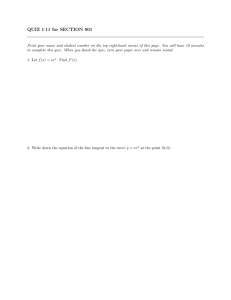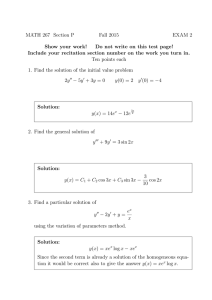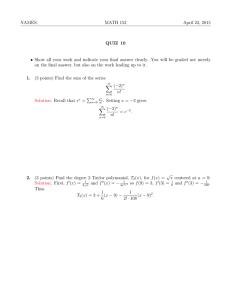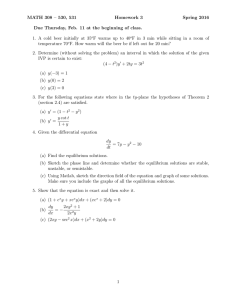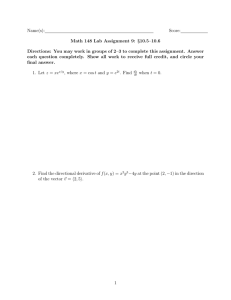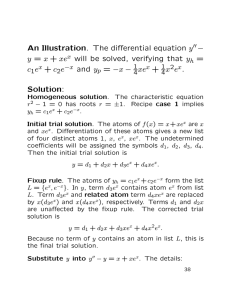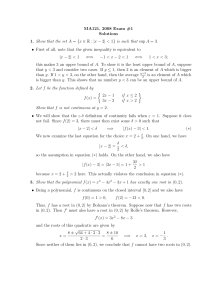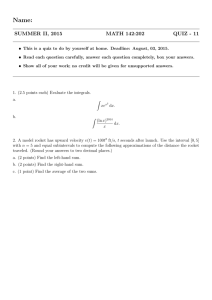Undetermined Coefficients, Resonance, Applications • An Undetermined Coefficients Illustration Pure Resonance
advertisement
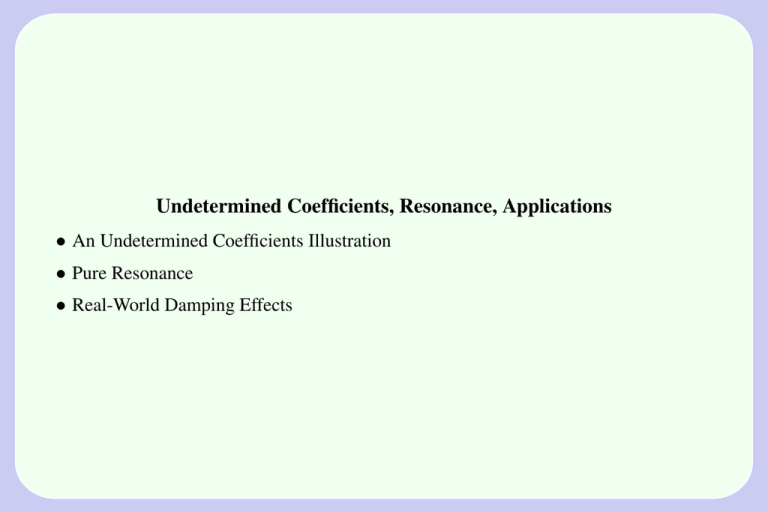
Undetermined Coefficients, Resonance, Applications • An Undetermined Coefficients Illustration • Pure Resonance • Real-World Damping Effects An Undetermined Coefficients Illustration The differential equation y 00 −y = x+xex will be solved. Verified for general solution y = yh + yp are the formulas 1 1 yp = −x − xex + x2ex. 4 4 yh = c1ex + c2e−x, Homogeneous solution. The homogeneous equation y 00 − y = 0 has characteristic equation r 2 − 1 = 0, roots r = ±1, and atom list ex , e−x . Then yh = c1 ex + c2 e−x . Rule I trial solution. Let f (x) = x + xex . The derivatives f , f 0 , f 00 , . . . have atom list 1, x, ex , xex. Then k = 4 is the number of atoms in the trial solution. Because atom ex is a solution of the homogeneous equation y 00 − y = 0, then Rule I FAILS. Rule II trial solution. Break up the atom list for f into groups with the same base atom, as follows. Group Atoms Base atom 1 1, x e0x 2 ex, xex ex Group 1 is unchanged, because the first atom 1 is not a solution of the homogeneous equation y 00 − y = 0. Group 2 has a FAIL, because the first atom ex is a solution of the homogeneous equation y 00 − y = 0, as seen in Rule I. We multiply group 2 by factor x, then the first atom is xex, which is not a solution of the homogeneous equation [Eulers theorem says xex is a solution if and only 1 is a double root of the characteristic equation r 2 − 1 = 0; it isn’t]. Group Atoms 1 1, x x New 2 xe , x2 ex The trial solution, according to Rule II, is a linear combination of the atoms in the last table. y = (d1 + d2x) + (d3xex + d4x2ex). Substitute the trial solution into the DE Substitute y(d1 + d2 x) + (d3 xex + d4 x2 ex ) into y 00 − y = x + xex . The details: LHS = y 00 − y Left side of the equation. = [y100 − y1] + [y200 − y2] Let y = y1 + y2 , y1 = d1 + d2 x, y2 = d3xex + d4x2ex. = [0 − y1]+ Use y100 = 0 and y200 = y2 + 2d3 ex + [2d3ex + 2d4ex + 4d4xex] 2d4ex + 4d4xex. = (−d1)1 + (−d2)x+ Collect on distinct atoms. (2d3 + 2d4)ex + (4d4)xex Write out a 4 × 4 system. Because LHS = RHS and RHS = x + xex , the last display gives the relation (1) (−d1)1 + (−d2)x+ (2d3 + 2d4)ex + (4d4)xex = (0)1 + (1)x + (0)ex + (1)xex. Equate coefficients of matching atoms left and right to give the system of equations −d1 (2) = −d2 = 2d3 +2d4 = 4d4 = 0, 1, 0, 1. Atom matching effectively removes x and changes the equation into a 4 × 4 linear system for symbols d1 , d2 , d3 , d4 . Atom Matching Explained. The technique is independence. To explain, independence of atoms means that a linear combination of atoms is uniquely represented, hence two such equal representations must have matching coefficients. Relation (1) says that two linear combinations of the same list of atoms are equal. Hence coefficients left and right in (1) must match, which gives 4 × 4 system (2). Solve the equations. The 4 × 4 system must always have a unique solution. Equivalently, there are four lead variables and zero free variables. Solving by back-substitution gives d1 = 0, d2 = −1, d3 = 1/4, d4 = −1/4. Report yp . The trial solution with determined coefficients d1 = 0, d2 = −1, d3 = −1/4, d4 = 1/4 becomes the particular solution 1 1 yp = −x − xex + x2ex. 4 4 Report y = yh + yp From above, yh = c1ex + c2e−x, 1 1 yp = −x − xex + x2ex. 4 4 Then y = yh + yp is given by 1 1 y = c1ex + c2e−x − x − xex + x2ex. 4 4 Answer check. Computer algebra system maple is used. yh:=c1*exp(x)+c2*exp(-x); yp:=-x-(1/4)*x*exp(x)+(1/4)*xˆ2*exp(x); de:=diff(y(x),x,x)-y(x)=x+x*exp(x): odetest(y(x)=yh+yp,de); # Success is a report of zero. Pure Resonance Graphed in Figure 7 are the envelope curves x = ±t and the solution x(t) = t sin 4t of the equation x00 (t) + 16x(t) = 8 cos ωt, where ω = 4. x t Figure 1. Pure resonance. The notion of pure resonance in the differential equation x00 (t) + ω02 x(t) = F0 cos(ωt) (3) is the existence of a solution that is unbounded as t → ∞. We already know that for ω 6= ω0 , the general solution of (6) is the sum of two harmonic oscillations, hence it is bounded. Equation (6) for ω = ω0 has by the method of undetermined coefficients the unbounded oscillatory solution x(t) = summarize: F0 2ω0 t sin(ω0 t). To Pure resonance occurs exactly when the natural internal frequency ω0 matches the natural external frequency ω , in which case all solutions of the differential equation are unbounded. In Figure 7, this is illustrated for x00 (t) + 16x(t) = 8 cos 4t, which in (6) corresponds to ω = ω0 = 4 and F0 = 8 . Real-World Damping Effects The notion of pure resonance is easy to understand both mathematically and physically, because frequency matching p ω = ω0 ≡ k/m characterizes the event. This ideal situation never happens in the physical world, because damping is always present. In the presence of damping c > 0, it can be established that only bounded solutions exist for the forced spring-mass system (4) mx00 (t) + cx0 (t) + kx(t) = F0 cos ωt. Our intuition about resonance seems to vaporize in the presence of damping effects. But not completely. Most would agree that the undamped intuition is correct when the damping effects are nearly zero. Practical resonance is said to occur when the external frequency ω has been tuned to produce the largest possible solution amplitude. It can be shown that this happens for the condition p (5) ω = k/m − c2 /(2m2 ), k/m − c2 /(2m2 ) > 0. p Pure resonance ω = ω0 ≡ k/m is the limiting case obtained by setting the damping constant c to zero in condition (8). This strange but predictable interaction exists between the damping constant c and the size of solutions, relative to the external frequency ω , even though all solutions remain bounded.
